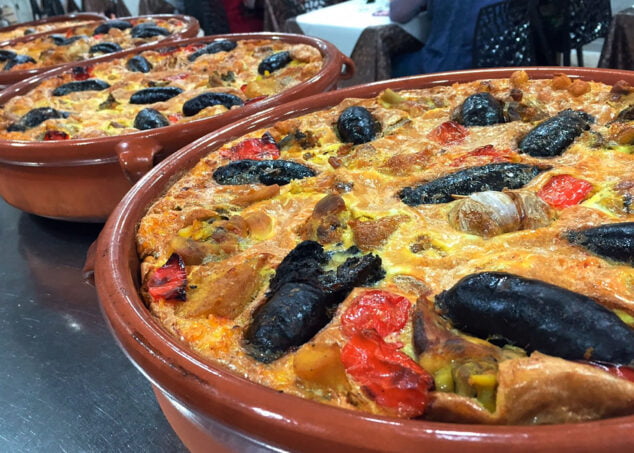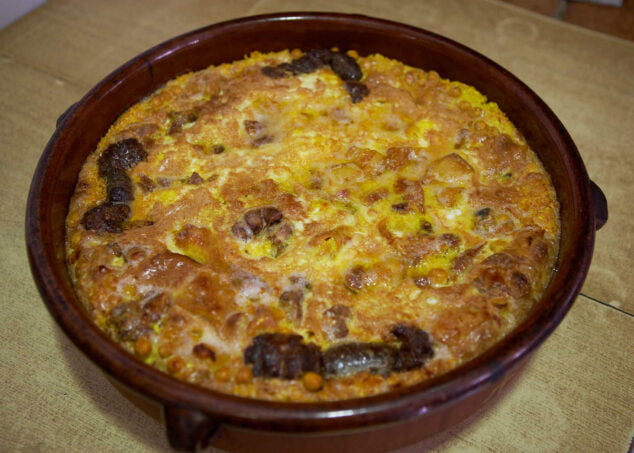El crust day It is a very popular day in Pego in which the most traditional dish of the municipality, the crosta, is tasted. The festival that is celebrated today is the result of the custom in Pego of taking advantage of Carnival Tuesday to eat meat and put an end to the excesses before beginning the Lent period.
Next you have an index with all the points that we are going to deal with.
When is
The day of the crosta in Pego is celebrated on Tuesday of Carnival, prior to Ash Wednesday. Each year the specific date of the celebration varies, since it revolves around Lent. In 2024,, the crusta pegolina is the 13 February.
What is
Tradition dictates that on the Tuesday after Carnival a day is held in which the typical and most defining dish of Pego, the crosta, is tasted. It's about a baked rice, typical of the Valencian Community, which is covered with beaten egg minutes before removing it from the oven so that the crust that is created comes out golden.
On the day of the crosta, the Pegolinos gather with family and friends to cook and eat the traditional dish. At present it is a way of continuing in some way with the carnival party. Although it is not officially recognized as a holiday, for many it is a holiday or even a day off.
Where to taste the crust of Pego
In Pego, most of the bars and restaurants that offer traditional food from the municipality sometimes serve rice with crust. One of the establishments where you can eat it is the Restaurant Rafel de Pego.
The bar offers a tasting menu of arròs amb crosta, although it is also usually available on the set menu of the day. Being one of its specialties, it can be ordered at any time on request.
History
The reason for this particular day has its origin in the most primitive celebration of Carnival in Pego. The documents of the Municipal Archive of Pego show that the carnival festival in the municipality was born in the middle of the XNUMXth century. It is dated in this way because it is when the first ordinances to prohibit the party begin to appear.
It should be remembered that at that time the carnivals were celebrated as a few days of excesses and debauchery prior to the 40 days of Lent. During this period marked on the Christian calendar, restrictions, fasting, and penances were common before beginning Easter.
More information and history of the Carnival of Pego.
Three days of Carnival
According to Pegoline oral tradition, Carnival was originally celebrated for three days in a row: Sunday, Monday and Tuesday before Ash Wednesday, when Lent began. One of the prohibitions, according to Christianity, was I do not eat meat during that Wednesday and the rest of the Fridays until Easter.
For this reason, one of the beliefs that gives meaning to the coating of baked rice with egg is that it was done to hide or cover heavier ingredients that were prohibited during Lent. That is, the meat.
As a way to put an end to the hours of excess and revelry, the inhabitants of Pego prepared their traditional dish, whose main ingredients are meat and sausage. Furthermore, it was the last day of the holiday, so They gathered to celebrate and relax before Lent.
The dictatorship and the prohibition of Carnival
With the arrival of the Civil War and the subsequent Franco dictatorship, in 1937 the celebration of Carnival was prohibited in those places occupied by rebels. In Pego the party is also banned, but its inhabitants They maintained the gastronomic tradition Nevertheless.
It was customary to meet with family and friends during the meal of the crust in the countryside, the mountains, the beach or in the areas furthest from the center of town, such as Calvari. The day was so important for the population that even in the schools excursions were organized that day so that the boys and girls of Pego could also eat the crust together with their educators.
There are various theories about how that day unfolded. One of them is that those who entered the mountains or places farthest from the dictatorial gaze took advantage of the day of the crosta to continue dressing up for Carnival despite the prohibition.
The day of the crust today
With the transition and the implementation of democracy in Spain, the Carnival was recovered from the 1980s. The day of the crosta was not prohibited, which is why it is said that survived the most turbulent years of the dictatorship and it continues to be celebrated today. Although the prohibitions for Lent are no longer a norm, the Pegolinos and Pegolinas take advantage of the day to meet with each other one more day without losing their most important gastronomic custom.












